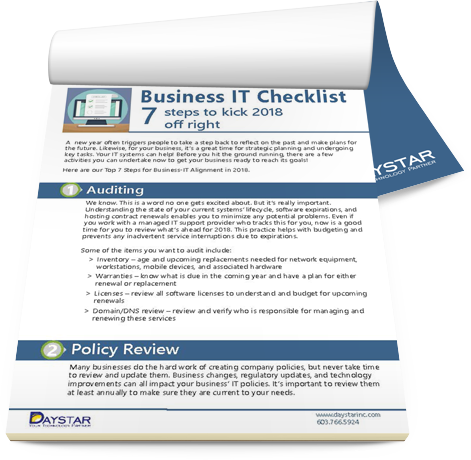Maybe you have worked with the same IT provider for some time. Perhaps, you handle IT yourself or task one of your employees with the responsibility. Regardless, you’re wondering if your current support is right for your business. The process of making a change may seem intimidating, but could the benefits make it worthwhile?
Often, there is no one reason a business decides it’s time to change IT providers, but rather a variety of contributing factors. It’s not always clear if the time is right. However, there are some general indicators that may help.
Here are three common causes businesses cite when they determine it’s time for a change.
Size
Size is one of the easiest triggers to identify. When the size of your business grows, your IT support needs can change. You begin to feel that you have outgrown your IT support. This normally manifests in one of three ways: numbers, dependency, and sophistication.
Adding employees or locations increases the number of devices and amount of equipment that must be supported and managed. For a single internal IT resource or a small break/fix provider, the difference in supporting 5 versus 15 employees is vast. When your numbers grow to the point that your current provider can’t keep up, it is time to consider upgrading to a more proactive managed IT services model.
When your size increases, your dependency on technology also grows. Consistent, reliable support is required. A single IT person who has other clients, takes periodic vacations, or even gets sick once in awhile cannot provide the availability you need. Whether it’s a help desk or a small support team, you now require multiple resources to ensure access to support when you need it.
As you grow, your technology needs often get more sophisticated. File sharing, email configurations, access rights, connectivity, and security become more complex. If your current IT provider does not have the knowledge and resources to expertly guide your business, it is time to find support that can.
Frustration
Whereas size is the easiest trigger to identify, frustration is the most common one we hear about when working with new clients. If you, or your team, are regularly dissatisfied with your IT support, consider that a big red flag. We usually see frustration stem from two main areas: support and account management.
Common support issues include:
- unresponsive service
- recurring problems
- finger pointing or blaming
- careless security processes
- a lack of listening or desire to understand
Frustrations with account management usually center around sales and billing. Excessive up-selling, unexpected charges, and a lack of transparency are some of the issues we hear about most often.
It’s important to understand that this frustration is more than simply aggravating; it also negatively impacts your business’ productivity and bottom line. Over time, the soft costs of lost productivity can be staggering. This is one area you want to address quickly should it occur.
Business Priorities
Just as the economy changes, so too can your business’ priorities. When you set new goals and strategic direction, it is a good time to review your IT service to make sure you have the right support to achieve your goals.
Although this is sometimes related to changes in a business’ size (as described above), it can also occur independently of actual increases in an organization’s headcount. For example, established businesses capitalizing on market changes and transitioning to a strong growth mindset begin to rely more heavily on technology. These fast-paced environments may require a level of service beyond what the business previously needed.
Increased security needs is another business priority that can signal the need for more sophisticated IT support. Implementing secure data access controls, antivirus solutions, and data backup configurations can quickly become complex as you work to minimize the security risks within your network environment. As ransomware and other cyberattacks have increased, security and risk management has become a more strategic business priority for many small and mid-sized businesses. This is especially true in specific industries governed by data security regulations, such as healthcare and financial services.
New workforce initiatives can also impact the type of support you require. For example, as more organizations shift to allow employees flexible work schedules, teleworking, and the ability to use their own personal devices for work (BYOD), their technology needs change to support that. Providing IT support to a remote workforce using a variety of computers, laptops, tablets, and smartphones may demand a higher level of technology expertise than you currently have available to you.
It’s important to periodically review your current IT support to ensure it keeps pace with your business needs.
Get Off Cruise Control
Technology can be confusing and intimidating; once a support plan is in place, many businesses leave it alone. Unless something goes drastically wrong, they adopt a “set it and forget it” approach.
But your business does not stand still, and neither should your technology. Technology shouldn’t just support your business; it should optimize it, make it better, and enable you to reach your goals. Periodic reviews, performed at least annually, will help either confirm your plan or identify when it’s time to make changes in your IT support.
Need help reviewing your current IT support? Reach out to us today.
















